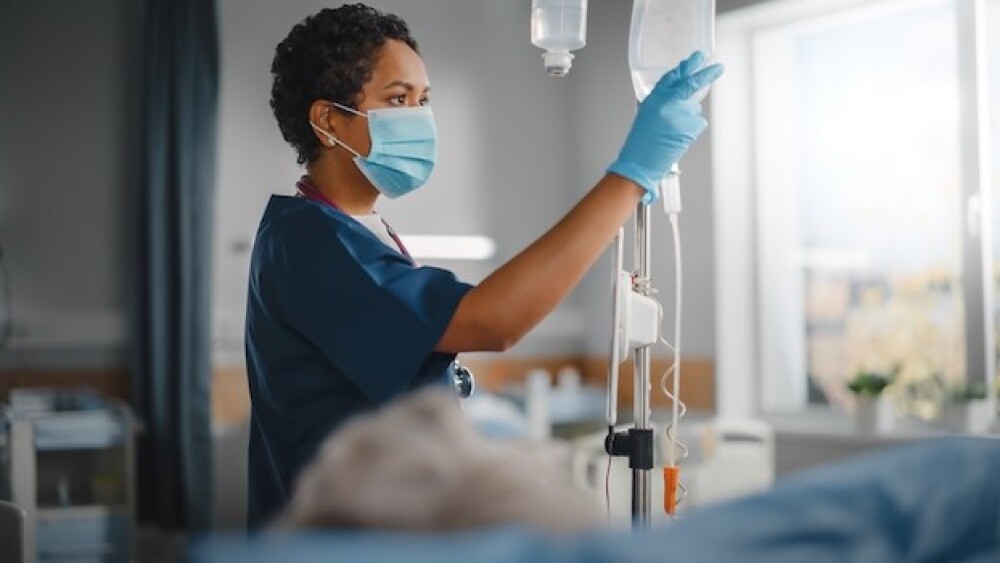CSL’s AEGIS-II trial and cell and gene therapy expansion highlight the significant global expansion within the company over the past five years.
Pictured: Nurse administers IV/iStock, gorodenkoff
Recently, global biotechnology leader CSL—including CSL Behring, CSL Seqirus and CSL Vifor—has experienced rapid globalization and R&D expansion encompassing six therapeutic areas and four scientific platforms. Over the past five years, CSL has invested $4.6 billion USD in R&D globally.
The company has aggressively targeted cardiovascular and metabolic diseases in its portfolio expansion, spawning its largest clinical trial to date, AEGIS-II. The Phase III multicenter study began in 2018 and has enrolled an estimated 18,200 heart attack patients worldwide.
AEGIS-II is testing the potential of CSL112, a cholesterol efflux enhancer, to reduce the risk of a recurrent adverse cardiovascular event during the critical 90-day period after a heart attack. A 2021 meta-analysis published by the BAIM Institute, CSL Behring and other collaborators showed that approximately half of recurrences in the first year following a heart attack happen within the initial 90-day period.
Plasma Protein Technology
CSL112 is a novel infusible human plasma-derived apoA-I, a primary functional component of high-density lipoproteins (HDL). When CSL112 is infused into the bloodstream after a heart attack, it enhances HDL’s ability to remove excess cholesterol from cells within atherosclerotic plaque, Andreas Gille, executive director cell & gene therapy development and Pasadena R&D site head, told BioSpace. This is hypothesized to lead to stabilization of remaining plaque and thereby reduce the risk of recurrent adverse cardiovascular events.
Gille said CSL112’s novel apoA-I mechanism may offer a potential breakthrough for heart attack patients. If approved, it would become the first therapy to reduce the risk of a recurrent heart attack through this approach, according to CSL.
The AEGIS-II trial will demonstrate whether CSL112 could save the lives of heart attack patients, Gille said. “It would be transformative.”
Having spent nine years working on the development of CSL112, Gille experienced first-hand the company’s global R&D evolution and growth.
“We started CSL112 development in Australia, but then it became a globally run project,” he said. “CSL112 was the first clinical development program that was run by a global team and piloted the globalization of CSL R&D.”
AEGIS-II recruited the last patient in November 2022, with the results of the trial expected in early 2024.
Cell and Gene Therapy
Another key platform at CSL is cell and gene therapy.
CSL launched into the C> space by acquiring Calimmune in 2017, and matured its portfolio with U.S. regulatory approvals in November of 2022 and EU and U.K. approvals earlier this year of Hemgenix (etranacogene dezaparvovec-drlb), the first and only one-time gene therapy for certain adults with hemophilia B, following the acquisition of global rights to commercialize the treatment from uniQure.
Calimmune, a Caltech spinoff, had a R&D facility located in Pasadena, which was fully integrated into CSL R&D. “The site presented an opportunity to build the hub of cell and gene therapy R&D for CSL,” Gille said. “For CSL, the acquisition has meant embracing cell and gene therapy as a novel treatment modality.”
Gille’s team is developing the company’s portfolio and applying cell and gene therapies to diseases like Wiskott-Aldrich Syndrome (WAS), a rare X-linked disorder occurring in an estimated 10 cases per million males worldwide. WAS impairs immune system function and leaves patients more vulnerable to infection and other health complications, Gille said.
This approach offers a significant opportunity to improve the lives of patients with serious and life-threatening diseases, and holds great promise for the future of medicine, he said. “Developing a treatment option for very sick children that has the potential to cure them of the disease—that’s really very motivating for us.”
The Pasadena site is participating in several strategic collaborations to drive R&D innovation. A partnership with Seattle Children’s Research Institute inked in 2020 seeks to create pioneering gene therapies for primary immunodeficiency diseases, including WAS.
Local academic institutions like City of Hope, UCLA and Caltech also provide opportunity for collaboration that could facilitate CSL Behring’s move into the gene editing space—a goal Gille envisions for the Pasadena site this year.
State-of-the-Art Local Manufacturing
The cell and gene therapy hub in Pasadena has seen significant investment and growth. “We have quadrupled the lab space and the number of people,” Gille said. “We just celebrated the handover of the GMP cell and gene therapy manufacturing facility to operations after it was fully validated. That’s a really big milestone for us.”
The Pasadena site is the only CSL facility capable of manufacturing cell-based gene therapies and medicines. Creating robust cell and gene therapies is a tricky process, Gille said. The starting material of these therapies are the blood stem cells of the patients, introducing a higher degree of variability than usual in the manufacturing process.
“Our understanding of that variability and coming up with state-of-the-art manufacturing processes—that’s what we want to do here. We can imagine a world in the future where patients don’t just get a treatment—they get a cure.”
Caleigh Findley is a freelance science writer based in Colorado. She can be reached on LinkedIn.
Featured Jobs on BioSpace






